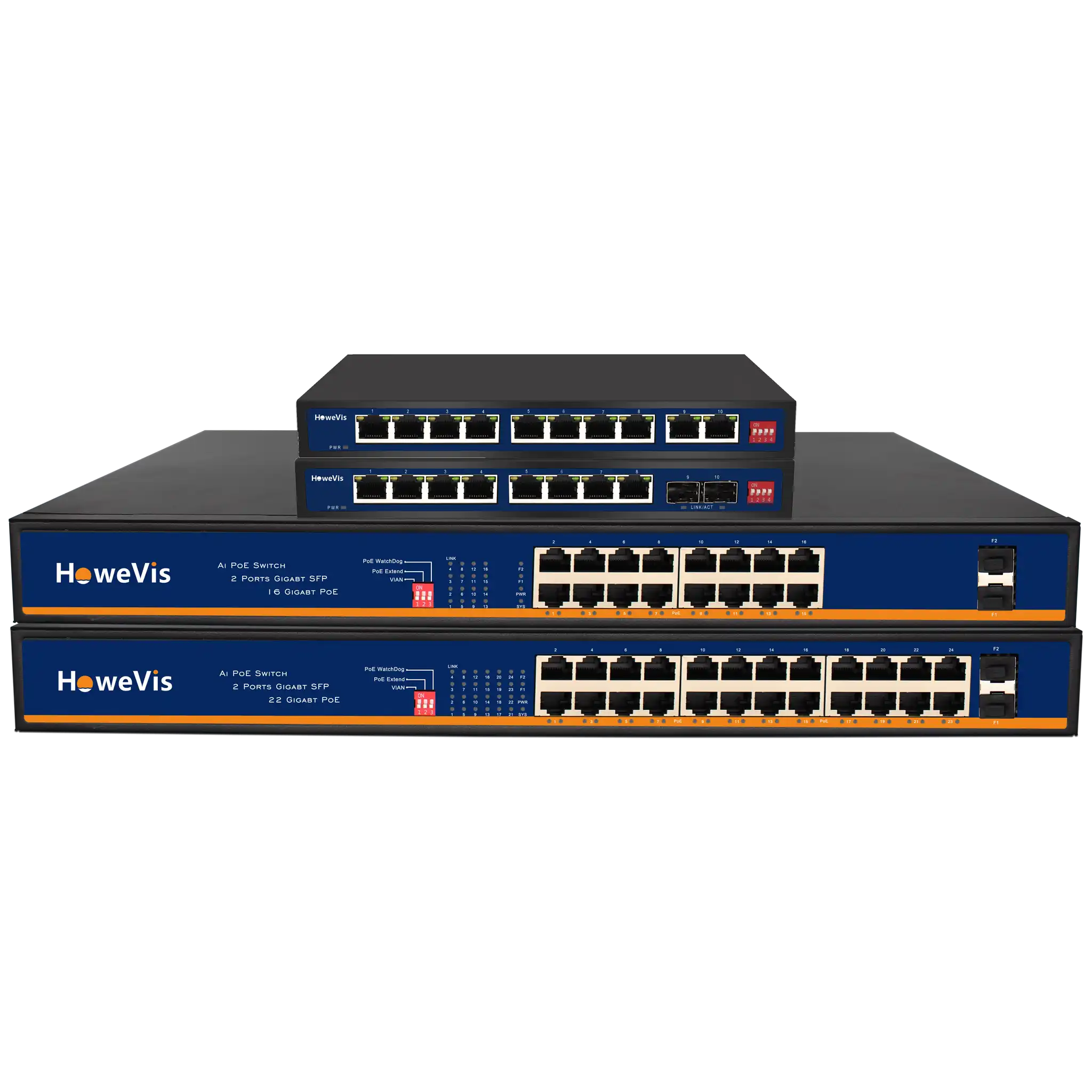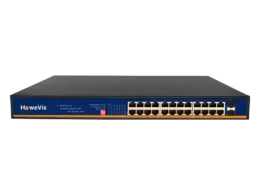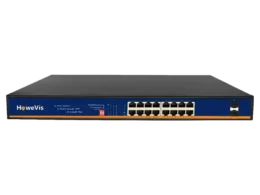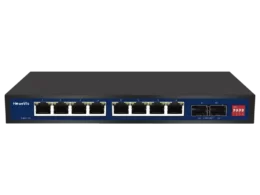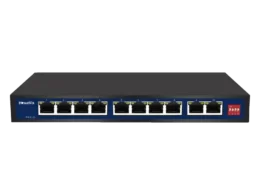Did you know that modern businesses now demand network connectivity over distances that traditional switches can’t handle? That’s where our expertise with long-distance PoE switches comes into play. We understand your challenges when expanding your network reach—across a large campus or connecting multiple buildings. With a reliable long-distance PoE switch, not only do we bridge vast physical gaps, but we also ensure seamless power and data flow to essential devices without the need for additional infrastructure.
Our journey together in this blog post is about simplifying complex networking dilemmas. We’re peeling back the layers of technical jargon to reveal how a long-distance PoE switch can revolutionize your network setup, making it more efficient and cost-effective than ever before.
Exploring the Basics of PoE Technology
PoE Defined
PoE, or Power over Ethernet, is a technology we often use. It lets network cables carry electrical power. For example, a digital camera can get power and data through one cable. This makes setting up devices simpler.
With PoE, we don’t need extra wiring for power outlets near each device. It’s great because it reduces clutter and cost in our setups.
Operational Principles
Understanding how PoE works is essential for us. A PoE switch combines data and power on the same network cable. The power comes from a central source like a switch designed to run on low-voltage electricity.
This means we can place devices where there are no power lines. We’ve found this very useful in hard-to-reach places.
Simplified Cabling
The beauty of using PoE tech lies in its ability to dramatically cut down on cabling needs. We no longer have to juggle multiple wires for every device—one does it all!
For instance, when setting up Wi-Fi access points across an office space, only needing one cable per point simplifies our job greatly.
Standards & Governance
There are specific standards governing how Power over Ethernet should work safely and effectively:
- IEEE 802.af (up to 15W)
- IEEE 802.at (up to 30W)
These standards ensure devices from different manufacturers play nicely together, which is crucial for us as consumers looking at various options, such as OEM or ODM solutions from suppliers or vendors.
Advantages of Using Long Distance PoE Switches
Extended Reach
Our experience with long-distance PoE switches has shown us their incredible ability to extend network reach. These devices ensure that the signal remains strong, even over extended distances. This means we can connect cameras or access points much farther than standard Ethernet limits allow.
Using a long-range PoE extender, our networks can cover vast areas without losing data quality. Imagine setting up surveillance in a large warehouse; these switches make it possible without complex wiring.
Cost Efficiency
One significant benefit we’ve noticed is the cost savings on infrastructure. A long-distance PoE switch reduces the need for additional electrical wiring and outlets. We find this particularly useful when deploying systems across multiple floors or buildings.
With fewer cables, the installation involves fewer labor and material costs. It’s an economical choice for growing networks where budget matters as much as performance.
Remote Powering
The ease of powering devices in remote locations stands out. These switches provide power and data over one cable, whether outdoor Wi-Fi access points or IP cameras. This simplifies deployment in challenging environments where power sources are scarce.
We’ve powered devices located hundreds of meters away using a long reach PoE solution—a task that would have been daunting before this technology came into play.
Key Features of High-Performance PoE Switches
Power Budget
A PoE switch must have a sufficient power budget. This is the total amount of power it can provide to connected devices. We look for switches that can handle our network’s power needs without strain.
High-performance models often offer more wattage per port. They ensure stable connections even as we add more devices. For example, an AI-powered PoE might adjust power allocation dynamically, which is crucial when managing several high-power gadgets.
Installation Tips for Long Range PoE Setups
Planning Phase
Before we dive into the physical setup, planning is crucial. We need to map out network requirements and device placement.
First, let’s identify all devices that will connect to our network. This includes cameras, access points, or phones. We’ll consider each device’s power needs and data demands. Next, it’s about layout—where these devices go and how they connect to our central network hub.
Now comes the cable path: we must find efficient and practical routes. Obstacles like walls or large metal objects can interfere with signal quality; thus, strategic routing avoids such pitfalls.
Cable Quality
Choosing the right cables is non-negotiable for optimal performance in a long-range PoE setup.
We recommend Category 6 (Cat6) cables or higher for long distances due to their enhanced signal integrity over extended lengths. These cables support up to 10 Gigabit speeds over 100 meters—perfect for high-performance networks like ours.
Another critical factor is shielding; shielded twisted pair (STP) cables reduce interference from external sources, which could disrupt communication between devices on our network.
Device Positioning
Proper positioning of PoE switches and connected devices maximizes efficiency and coverage.
Our switches should be central relative to connected devices but also accessible in case we need maintenance or adjustments later on. For instance, placing a switch upstairs when most users are downstairs might result in weaker signals where needed most.
Devices require thoughtful placement —higher positions often work best for Wi-Fi access points as they provide broader coverage areas without obstructions blocking signals. Cameras should have clear lines of sight while avoiding direct sunlight exposure, which can adversely affect image quality.
Cost-Benefit Analysis for Different Business Types
Upfront Expenses
We know that every penny counts in business. So, when we look at the upfront costs of long-distance PoE switches, it’s clear they vary by scale. A small company might cringe at the initial price tag. But let’s break it down.
For a tiny office, buying a few switches may seem steep. Yet these devices can power cameras and phones over one cable each. This means less wiring and fewer installation hours. It saves money right away.
A large manufacturer has different needs. They may need dozens of switches to cover vast spaces with Wi-Fi or security systems. The cost is higher upfront, but spread across many devices, the per-unit expense drops.
Long-Term Savings
Over time, savings become obvious with long distance PoE solutions. Small businesses see utility bills shrink as fewer cables mean less power used overall. Mid-sized companies benefit from reduced downtime thanks to reliable connections. Large enterprises watch maintenance expenses fall because PoE tech is sturdy and lasts longer than traditional setups.
Operational Impact
Its value shines through when we assess how long-distance PoE touches daily operations. In retail stores or hotels, seamless network coverage ensures customer satisfaction—a big win for brand loyalty. Factories enjoy streamlined processes as machinery connects flawlessly across distances without lagging data transfer.
This tech also allows remote management of devices, which slashes man-hours spent on troubleshooting across sprawling sites like campuses or hospitals.
ROI Assessment
Now, let’s talk about return on investment (ROI). We’ve seen firsthand how intelligent choices pay off over time. Investing in a few units for startups or local shops could mean quick returns as productivity rises without massive overheads. Medium-sized firms might upgrade their network system with long-distance PoE and recover costs within months due to improved efficiency and lower operational fees.
But for giants—think international distributors or exporters—the strategic deployment of this technology can reshape budget forecasts entirely with significant savings year after year.
Real-World Applications and Case Studies
Surveillance Success
We’ve seen firsthand how long-distance PoE switches revolutionize security systems. Traditional power solutions struggle to cover all the necessary ground in large properties. But with PoE, cameras can be placed anywhere data and power travel on the same cable.
In a recent case study, a sprawling industrial complex upgraded its surveillance system using long-distance PoE switches. They installed high-definition cameras at distant locations without worrying about power outlets. The result? A seamless view of their entire operation that significantly improved safety.
Hospitality Integration
The hospitality industry thrives on customer satisfaction. We observed how hotels use long-distance PoE to enhance guest experiences through intelligent room technology. Imagine entering your hotel room and having the lights, temperature, and TV adjust automatically to your preferences.
This isn’t just convenient for guests; it’s efficient for hotel management. With these systems in place, energy usage drops as rooms adapt based on occupancy sensors—talk about intelligent savings!
Smart Buildings
Smart buildings are not just structures but dynamic environments that interact with occupants and adjust accordingly. Long-distance PoE plays a crucial role here by powering devices essential for IoT integration, such as thermostats, light controls, and sensors all over the building.
A notable example is an office block where every floor was optimized for comfort and efficiency using IoT devices powered by long distance PoE switches. This setup allowed facility managers to gather valuable information on space utilization, leading to better decision-making.
Productivity Boosts
Lastly, we’ll review how productivity skyrockets when businesses effectively implement long-distance PoE technology. Consider warehouses where inventory tracking is vital; installing wireless access points via PoE ensures real-time updates flow smoothly between staff handhelds and central databases.
One particular warehouse reported cutting down inventory check times by half after switching to a PoE-powered network—a clear sign of enhanced operational efficiency thanks partly to this versatile tech solution.
Troubleshooting Common Long Distance PoE Issues
Voltage Drop
We understand that a voltage drop is a big concern with long distance PoE switches. It happens when power degrades as it travels over the cable length. This can cause devices to receive less power, leading to performance issues or failure.
To combat this, we check the quality of our cables and ensure they are within recommended lengths. We also consider using a range POE extender, which boosts signal strength without compromising data integrity.
Another quick fix is upgrading to thicker gauge Ethernet cables. They have lower resistance and help in reducing voltage drop significantly.
Interference Challenges
Interference can disrupt connectivity in long-range setups. Sources include electrical equipment and other wireless signals.
Our approach includes running cables away from interference sources whenever possible. Shielded twisted pair (STP) cabling also helps by protecting against electromagnetic interference (EMI).
We look into long-reach PoE solutions with built-in noise immunity features for severe cases. These advanced options often come at a higher price but provide peace of mind for critical applications.
Connectivity Problems
Connectivity issues are common headaches for us with long range PoE networks. Devices sometimes fail to connect or lose connection sporadically due to various reasons, including poor termination or damaged cables.
We tackle these by double-checking connections at both ends of the cable run. A simple re-termination often fixes connectivity woes. If problems persist, we perform cable tests using network testers to pinpoint exact fault locations.
A high-quality tester is an invaluable tool—it saves time and frustration in troubleshooting complex networks like ours.
Diagnostic Tools
Maintaining a healthy network requires constant vigilance, and practical diagnostic tools are essential. Network analyzers help us monitor traffic flow and identify bottlenecks before they become serious problems. For more advanced diagnostics, AI-driven tools like an AI POE switch can predict failures through pattern recognition—proactively suggesting maintenance actions before downtime occurs.
Comparing Long Distance PoE Switches and Brands
Performance Metrics
When evaluating long distance PoE switches, performance is critical. We look at data throughput, power delivery, and reliability over extended distances. Some brands excel in delivering high-speed connections, while others focus on maximizing the power budget for devices.
In our experience, a long reach PoE solution must balance speed with stability. For example, we’ve specific long-range PoE switches that maintain robust performance beyond standard ranges of up to 100 meters. These are ideal for large installations like campuses or industrial settings where devices are spread out.
Compatibility Issues
Compatibility is another critical aspect we consider. It’s essential that a long distance PoE switch works seamlessly with various manufacturers’ equipment without hiccups or extensive configuration hassles.
We’ve found some brands offer better cross-compatibility than others. A long-range phone extender from one brand may not play well with another’s cameras or access points. This can be frustrating when integrating systems from different vendors.
User Experiences
Lastly, we critique user experiences, which greatly inform purchasing decisions. Online forums and reviews provide insights into how these products perform in real-world scenarios.
For instance, HoweVision’s long-distance PoE switch has garnered positive feedback for its ease of use and setup process—a big win for those who aren’t tech-savvy but need reliable reach PoE solutions.
HoweVision AI PoE Switches
Feature Overview
Our journey into the networking world leads us to HoweVision’s AI PoE switches. These devices stand out with their advanced features. PoE watchdog ensures reliability by automatically rebooting unresponsive cameras or access points. This is crucial for maintaining a secure and efficient network.
The switches also boast PoE long range, extending power over Ethernet connections beyond standard limits. This feature is handy when devices must be powered at greater distances, eliminating the need for additional extenders or power sources.
Other notable functionalities include support for Virtual Local Area Networks (VLANs). VLANs help segment network traffic, improving security and traffic management across our system.
Model Variations
We’ve discovered that HoweVision offers four models in this series, catering to various needs and scales of operation:
- 8 Ports Gigabit PoE Switch with 2 SFP
- 8 Ports Gigabit PoE Switch with 2 RJ45
- 16 Ports Gigabit PoE Switch with 2 SFP
- 24 Ports Gigabit PoE
Each model provides ample ports for multiple devices, ensuring scalability and flexibility within our network setup.
For smaller setups or those just starting, the 8-port models are ideal – offering either SFP or RJ45 uplink options depending on our preference for fiber connectivity or traditional copper-based networking.
More extensive networks can benefit from the 16-port and even more from the expansive 24-port switch, providing extensive connectivity options while incorporating all of HoweVision’s standout features like long-range power supply capabilities.
Practical Benefits
In practice, these switches have proven invaluable in building robust networks.
- The AI-powered aspects streamline troubleshooting.
- Long reach capabilities allow us to connect equipment far away without losing signal integrity.
- VLAN functionality enables us to manage traffic across different departments within an organization seamlessly.
These practical benefits have saved time and reduced costs associated with infrastructure expansions usually required when scaling up operations.
Keeping Up with Advancements in PoE Technology
Emerging Trends
Power over Ethernet (PoE) technology has transformed how we power devices. Higher power outputs are now a reality, allowing more devices to be powered by a single source. Imagine security cameras or telephones that no longer need separate power supplies; this is possible with today’s long distance PoE switches.
We’ve also seen more intelligent energy management systems emerge. These systems ensure that energy is not wasted and is distributed efficiently across all connected PDs (Powered Devices). For instance, an AI PoE switch can prioritize which device gets power first based on necessity.
- Higher wattage capabilities
- Energy-efficient operations
Future Enhancements
Standardization will become essential for interoperability between different manufacturers’ products. This means our long range PoE extender will work seamlessly with other brands’ equipment without hassle.
Continuous learning helps us leverage new features as they arise. We stay updated on the latest long reach PoE solutions so we can use them effectively in our setups.
- Seamless device compatibility
- Easy integration of new technologies
As we keep exploring advancements in PoE technology, let’s remember to embrace change and innovation for better connectivity solutions.
Closing Thoughts
We’ve journeyed through the landscape of long distance PoE switches, uncovering their potential to revolutionize our tech setups. From grasping the nuts and bolts of PoE tech to navigating real-world applications, we’ve seen how these devices empower businesses with efficiency and adaptability. Our collective experience shows that whether you’re installing a new network or upgrading an existing one, choosing the right PoE switch is pivotal for optimal performance and cost savings.
Let’s not just read about it—let’s take action. It’s time for us to step up our game and harness the power of long distance PoE technology. So, grab your gear, reach out to a trusted supplier, and make the smart switch today. Let’s connect to success and stay ahead in this ever-evolving digital world. Ready to leap? Let’s do this!
Frequently Asked Questions
What is PoE technology, and how does it work?
PoE, or Power over Ethernet, is a system that passes electrical power along with data on Ethernet cabling. This allows a single cable to provide data connection and electric power to devices.
Why should I consider long-distance PoE switches for my network to connect PDs and plug-in devices and maintain Mbps speed with a distant view?
Long distance PoE switches extend the reach of your network beyond the standard 100 meters limitation, making them ideal for large-scale installations like campuses or industrial settings where devices are spread out.
What are some key features of a high-performance PoE switch with connected PDs, Mbps throughput, and plug-and-play functionality?
Look for features like high power per port, gigabit speed support, VLAN capabilities, and energy efficiency when selecting a high-performance PoE switch.
Can you give me simple installation tips for long-range PoE setups with connected PDs, using a kit, and adjusting the dip switch for optimal Mbps?
Absolutely! Always plan your layout carefully, use quality cables rated for outdoor use if applicable, and consider adding surge protectors to safeguard against voltage spikes.
How do different business types benefit from investing in long distance PoE switches?
Businesses can reduce cabling costs and complexity while enjoying flexible device placement. For example, warehouses can easily connect cameras without nearby power outlets.
Could you share examples of real-world applications of long distance PoE switches?
Sure! Long distance PoE is used in IP surveillance systems at airports or lighting controls in innovative city projects where distances between devices exceed standard limits.
What common issues might I face with long-distance PoE setups, and how can I troubleshoot them?
Typical issues include voltage drop over longer runs or intermittent connectivity. To troubleshoot these problems, ensure proper cable quality/lengths and secure all connections.
